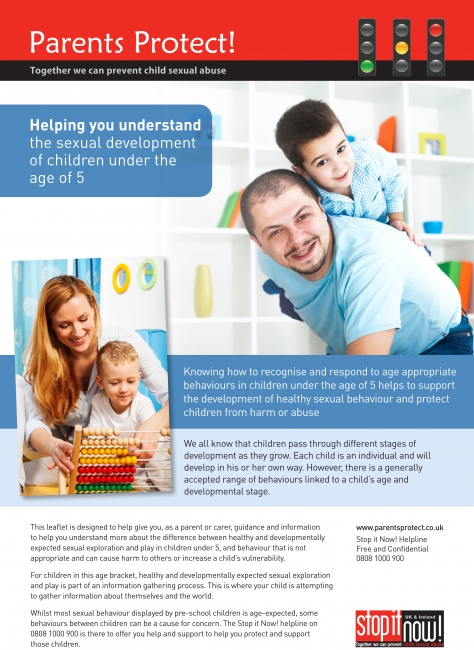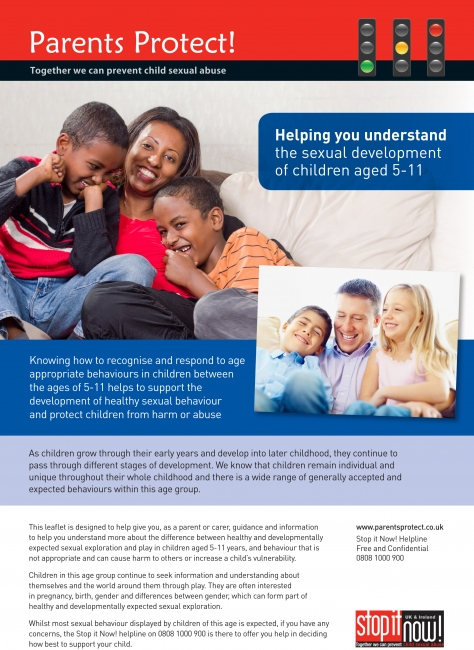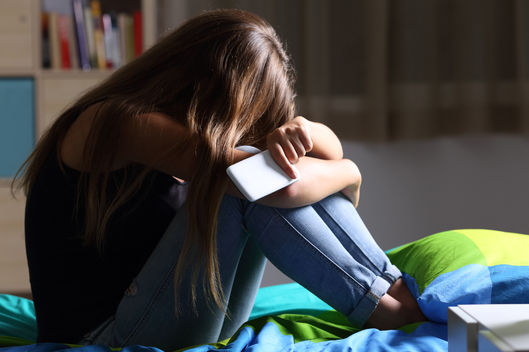Contents
- Harmful Sexual behaviour in young people and children
- Warning signs that a child may be a risk
- Is the behaviour age appropriate or is it harmful?
- Downloadable content
- Healthy Development Vs Harmful Behaviour (for 5-12 year olds)
- Healthy Development Vs Harmful Behaviour for Under 5s
- Healthy Development Vs Harmful Behaviour for Adolescents
- Further Information - Brook Traffic Light tool
Harmful Sexual Behaviour displayed in young people and children
We are becoming increasingly aware of the risk of sexual abuse that some adults present to our children and there is a growing understanding that this risk lies mostly within families and communities.
But very few people realise that other children can sometimes present a risk. A third of those who have sexually abused a child are themselves under the age of 18.
This is an especially difficult issue to deal with, partly because it is hard for us to think of children doing such things, but also because it is not always easy to tell the difference between normal sexual exploration and abusive behaviour.
Children, particularly in the younger age groups, may engage in such behaviour with no knowledge that it is wrong or abusive. For this reason, it may be more accurate to talk about sexually harmful behaviour rather than abuse.
Warning signs that a child may be a risk to another child.
Do you know a child who is:-
Confused about social rules and interactions
- May experience typical gestures of friendliness or affection as sexual?
- Explores his or her own natural sexual curiosity with younger children or those of differing size, status, ability, or power?
- Seeks out the company of younger children and spends an unusual amount of time with them rather than with peers?
- Takes younger children to “secret” places or hideaways or plays “special” games with them (e.g. playing doctor, undressing or touching games, etc.)?
- Insists on physical contact with a child when the child resists the attention
Anxious, depressed or seeming to need help
- Tells you they do not want to be alone with a child, or group of children, or becomes anxious about being with a particular young person?
- Was physically, sexually or emotionally abused and has not been offered adequate resources and support for recovery?
-Seems to be crying for help, i.e. behaves as if they want to be caught; leaves “clues” or acts in ways that seem likely to provoke a discussion about sexual issues?
Impulsively sexual or aggressive
- Links sexuality and aggression in language or behaviour (e.g. makes sexual threats or insults)?
- Unable to control inappropriate sexual behaviours involving another child after being told to stop?
- Engages in sexually harassing behaviour?
- Shares alcohol, drugs, or sexual material with younger children or teens?
- Views sexual images of children on the Internet or elsewhere?
- Forces sexual interaction, including direct contact and non-contact (like exposing genitals) on another adolescent or child?
These could be signs that a child may be a risk to another child. This is an especially difficult issue to deal with, partly because it is hard for us to think of children doing such things.
Is the behaviour age appropriate or is it harmful?
Children pass through different stages of development as they grow. Their awareness and curiosity about sexual matters change as they pass from infancy into childhood and then through puberty to adolescence.
Each child is an individual and will develop in his or her own way. However, there is a generally accepted range of behaviours linked to a child's age and developmental stage. It can be difficult to tell the difference between age appropriate sexual exploration and warning signs of harmful behaviour.
There may be some exploration with other children of similar age and we may need to explain to children why we would prefer them not to continue with a particular behaviour. This could be an opportunity to talk with them about keeping themselves and others safe and to let them know that you are someone who can be trusted and will listen.
Disabled children may develop at different rates, depending on the nature of their disability, and they can be more vulnerable to abuse. Children with learning disabilities, for example, may behave sexually in ways that are out of step with their age. Particular care may be needed in educating such children to understand their sexual development and to ensure that they can communicate effectively about any worries they have.
It is important to recognise that while people from different backgrounds have different expectations about what is acceptable behaviour in children, sexual abuse happens across all races and cultures.
Downloadable Leaflets
 |
Helping you understand the sexual development of children under the age of 5 |
 |
Helping you understand the sexual development of children aged 5-11 |
These leaflets are from our Parents Protect website.
They will provide further information to help you to understand more about the difference between healthy and developmentally expected sexual exploration and play in children and young people, and behaviour that is not appropriate and can cause harm to others or increase a child's vulnerability.
Healthy Development Vs Harmful Behaviour (for 5-12 year olds)
| School-age children (6-12 years) commonly: | They rarely: |
| Ask questions about menstruation, pregnancy and other sexual behaviour | Masturbate in public |
| Experiment with other children, often during games, kissing, touching, showing and role playing e.g. mums and dads or doctors and nurses | Show adult like sexual behaviour or knowledge |
| Masturbate in private |
Healthy development Vs Harmful behaviour (for Under 5's)
| Pre-school children (0-5 years) commonly: | They rarely: |
| Use childish 'sexual' language to talk about body parts | Discuss sexual acts or use sexually explicit language |
| Ask how babies are made and where they come from | Have physical sexual contact with other children |
| Touch or rub their own genitals | Show adult-like sexual behaviour or knowledge |
| Show and look at private parts |
Healthy Development Vs Harmful Behaviour (for Adolescents)
| Adolescents commonly | They rarely: |
| Ask questions about relationships and sexual behaviour | Masturbate in public |
| Use sexual language and talk between themselves about sexual acts | Have sexual contact with much younger children of adults |
| Masturbate in private | |
| Experiment sexually with adolescents of similar age |
Further Information - Brook Traffic Light tool
More information about expected, normal sexual behaviour for children at different ages, and how this differs from harmful sexual behaviour, can be found at Brook Traffic Light tool.
This resource was developed for child care professionals but may be of interest to parents and any adults concerned about a particular child.
Did you know?
Girls aged between 15 and 17 are at the highest risk of sexual abuse.
Source - Health Scotland
Read more






